Eighty-five years ago, the Turkish military slaughtered between 7,000 and 15,000 Kurds in less than a week in Zilan Valley in North Kurdistan (southeast Turkey). Some historians put the figure at 47,000 Kurds killed by the Turkish state.
The Kurdish Republic of Ararat, 1927 – 1930
From 1927 to 1930, Kurds established the independent Kurdish Republic of Ararat with its capital in Bayazit next to Mount Ararat in what is today Agri province. Official Turkish history refers to this Kurdish movement for independence as the Ararat Rebellion or Agri Rebellion.
The Turkish government mounted a military campaign against the Kurds of Ararat and passed Law No. 1850 making it legal to kill any Kurd:
“killing Kurds or committing any actions individually or collectively against them from June 20, 1930 to December 10, 1930, by representatives of the state or the province, by the military or civil authorities, by guards or militia men, or by any civilian during the pursuit and extermination of the revolt (Ararat), will not be considered crimes.”
They also legislated a program of forced migration to empty the area of Kurds. With Turkish military war planes raining down bombs, many Kurds fled south to the region of Ercis on the north shore of Lake Van. The Zilan Valley, site of the July 13, 1930, massacre, is located north of Ercis.
“Cleaning Up” – Zilan Valley Massacre
The Zilan Valley Massacre was one of the final campaigns to stop Kurdish independence. The secret mission was referred to as “cleaning up.” History has deceptively rewritten this merciless slaughter in Zilan as part of putting down a rebellion.
The Turkish army used two corps (VII Corps and IX Corps) and 80 aircraft for the cleaning operation from July 8, 1930. Tens of thousands of soldiers surrounded the region and burned 44 villages to the ground around Ercis.
Villagers were tied to each other and shot by soldiers under the command of Captain Derviş Bey. Those who did not die from gun shots were bayoneted, including babies, pregnant women, and elderly.
According to Kakil Erdem, one of the survivors who eyewitnessed the Zilan massacre, thirty-five of his relatives were killed, and soldiers cut and opened the abdomen of a pregnant woman. Before his eyes, three of his relatives were scalped and two of his brothers were beaten to death.
Generally the date that the massacre took place was considered as July 13, 1930, but Yusuf Mazhar, who was the special correspondent of the daily Cumhuriyet that was the Turkey’s most widely read daily paper in 1930-1940s, reported by telephone on July 12, 1930, the cleaning in districts of Erciş, Mount Süphan and Zeylân was completely finished .
A soldier who was part of the massacre tells the story:
“They made women, children, babies, everyone living in the region, thousands of people to get into the Zilan river. Then these people were surrounded by machine guns. They [the commanders] put us, the privates, on the machine guns. Behind us, there were corporals and sergeants who had their rifles aimed at us. Behind the corporals and sergeants, in the third row, there were commissioned officers waiting with their loaded pistols, ready to fire. If we didn’t fire, the noncommissioned officers were going to shoot us. If the noncommissioned officers didn’t shoot us, the commissioned officers were to shoot them and us. We pulled the triggers. Thousands of bullets spit fire on the people in the river. The horrible cries of women, children, old and young men echoed in the river. After a while the cries turned into moans. Then the moans ended too. Along with old and young men’s bodies, corpses of thousands of women, children, babies in swaddling clothes were left in the pool of blood. The corpses began to rot after a while.”
Forced Migration and Censorship
After the genocidal attack, settlements were prohibited. Anyone who was not killed had to move west as part of Turkey’s policy of forced assimilation. Property was confiscated. In 1980, the Zilan Valley region was re-opened to settlement, and refugees from Afghanistan were relocated to Hasan Abdal.
In 2007, Ercan Öksüz and Oktay Candemir, journalists working for the Dicle News Agency, interviewed 94-year-old living eyewitness Kakil Erdem and published the interview with the title “Zilan Katliamı’nın Tanığı Konuştu”(Witness of Zilan Massacre Talks). The Van 2nd Criminal Court of First Instance tried the journalists for “inciting hatred and hostility” under Article 216. In 2009, each of them received a prison sentence of 6 months.
The estimated number of persons killed in the Zilan Valley Massacre surpasses the Dersim Massacre, yet today little has been reported on this event.
Residents Build Zilan Valley Memorial
In 2012, residents of Hasan Abdal in the Zilan Valley built a memorial, at their own expense, of white boulders on the spot where 7,000 people were massacred by the Turkish state.
Kasim Şahin, was a young man when he was shot in the massacre, but survived by being buried under the pile of corpses as people were shot and killed. He escaped with his life and moved back in the 1980s after the government allowed people to return. According to Kasim Şahin’s grandson, all the people from between 10 and 15 villages were brought to this one spot at the edge of the Zilan River and shot. Soldiers stood on the hill overlooking the flat grassy area and killed them. The river ran red. The soldiers then occupied the house which is still standing overlooking the massacre site.
Kasim Şahin’s grandson explained to Amy Beam how the residents of Hasan Abdul built the road to the killing site with an excavator and made the memorial of white boulders at their own expense.
When Beam asked the grandson how many people had visited to write about the memorial site, he replied “You’re the only one,” he said. “There was one man from the government who came up the first year and took some photos, then left without talking to anyone.”
Directions To Zilan Valley Memorial Site and Ilica Thermal Pools
Driving west to Ercis, a road sign today points to Ilica, at the top of the valley where one can soak in a private thermal pool. There is no sign mentioning “Zilan”. At the mouth of the Zilan River there is a small settlement of modern homes surrounded by hills. The village of Hasan Abdul is a one-hour drive north of Ercis. The memorial site is on the opposite side of the river, which is now only a small stream.
Today, much of the river at Hasan Abdul has been filled in with dirt, so it no longer runs directly next to the knoll from which the soldiers shot. Any local resident can show visitors the small bridge to cross the river and visit the memorial site.
References
- The Kurds: A Nation on the Way To Statehood, by Jamal Jalal Abdulla, (one of the best scholarly, summary histories available)
- Kurdish Republic of Ararat, Wikipedia
- Ararat Rebellion, Wikipedia
- Zilan River Massacre – Part 1, Aug. 22, 2009
- Zilan Massacre Kurdistan House, Dec. 28, 2011
- Zilan Massacre, Wikipedia
- Shedding Light on the Zilan Massacre in Turkey, by Emiko Jozuka, Southeast European Times, June 22, 2012
Dr. Amy L. Beam promotes tourism in eastern Turkey at Mount Ararat Trek and writes political and historical commentary on Kurds in Turkey at Kurdistan Tribune. Twitter @amybeam; amybeam@yahoo.com.
.jpg)



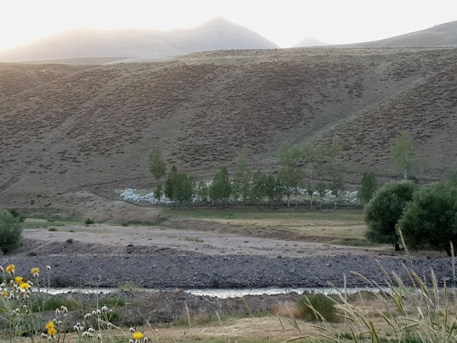
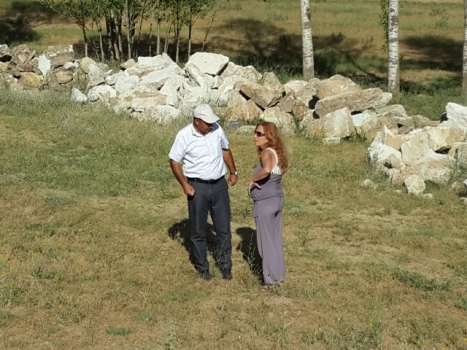
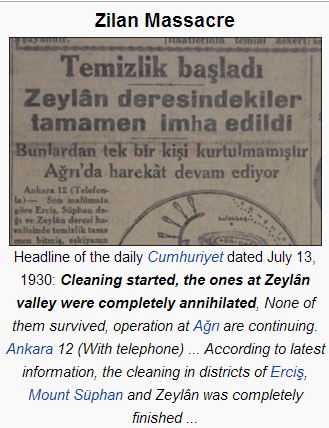

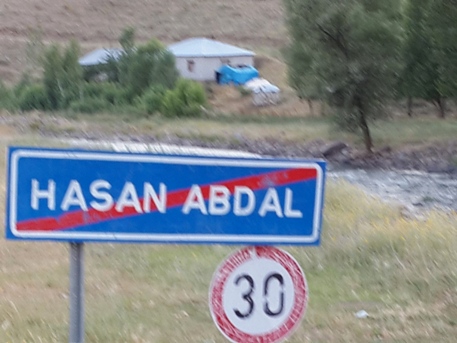
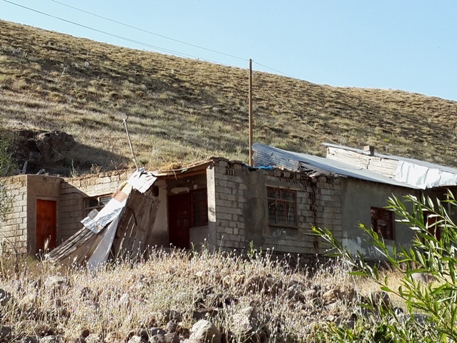
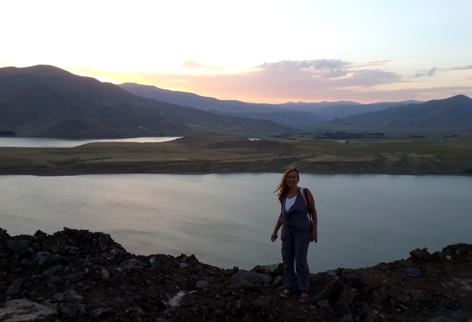
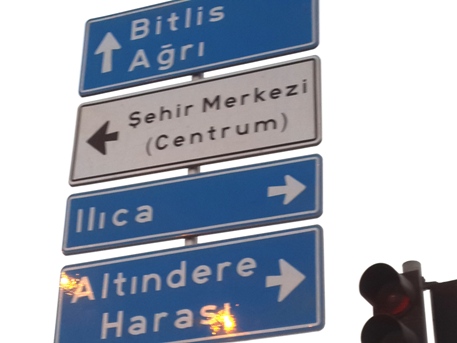
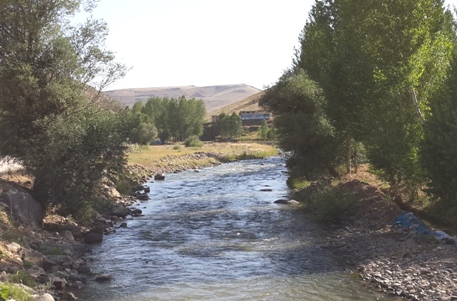

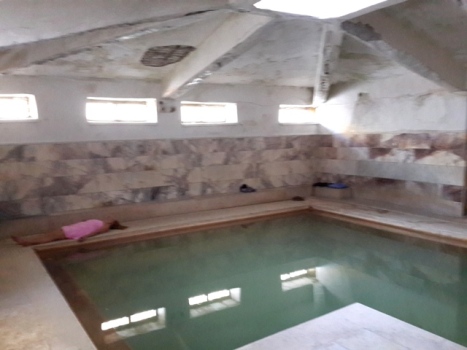

I would like to read an article on PEACE on KT please? I strongly believe independence can not move to the next phase in Iraqi Kurdistan until all wars stop. Thank you!
A quick observation:
Its always good to learn about state crimes and genocides. This was back in 30s. Eventually, God will make someone the cause to disclose the facts. Sometimes it takes a while.
In todays modern world, nothing has changed. Genocides take place even in more terrible and larger scale. The international community turned a blind eye to recent Yezedis , Kurds and Christian Genocides in Iraq and Syria committed by IS. Genocides must be stopped before its too late otherwise what is the point?
As always, thank you for your hard work.
[…] Turks, under the Ottomans killed tens of thousands of Kurds in massacres in Dersim and Zilan. By the 1990s, more than 3,000 Kurdish villages were destroyed. […]